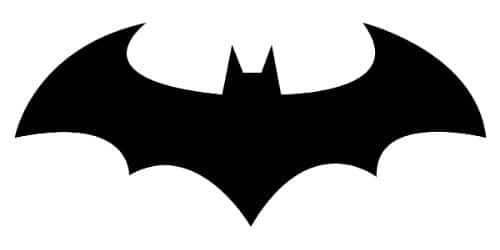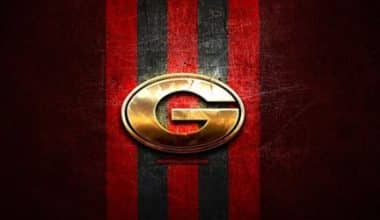The first Batman logo and symbol appeared eight decades ago and has gone through around 30 variations since then. Here’s a look at the logo’s many transformations in film and comic books. We will also discuss why the logo has always been identifiable.
What Exactly is Batman?
Batman is a superhero and one of the most well-known characters in comic books. He’s been around since 1939 when he originally appeared in the American publishing business DC Comics magazine.
The Batman logo is often a black bat silhouette with its wings spread wide. This picture has been made more than 30 times. But each time, he came with a different set of wings and a wide cloak. Furthermore, the logo has two versions: one for comics and one for film. The first list has 21 variations, while the second contains only 12.
Overall, the insignia has had a stormy history. The current version was made by Cathryn Laver (Calm the Ham), who took ideas from themed comics. Furthermore, its progress was constantly shifting from simple to multicomponent forms.
The History of the Batman Logo
Bruce Wayne was the superhuman detective when the Batman comic book debuted in 1939. Bruce’s explanation explains why the emblem was chosen in such an unusual way:
Folklore says that when Bruce was young, he swore to fight criminals after seeing a criminal group kill his parents in a horrible, cold-blooded way. The creator of the comics chose a bat to represent the fight against evil and the pursuit of justice. The hero grows stronger and stronger with each struggle and triumphs over himself, all without turning to dishonest means in his work.
What is the Original Batman Logo?
The first Batman emblem was the most simplistic in comic book history. The bat was a simple silhouette-like figure with no ears or head, and its size took up far less area on the suit than succeeding variants.
That same year, the emblem underwent various changes. Newer drawings show the bat with a small skull and two sharp-edged ears. At first, the top parts of the wings were round, but in later versions, they got sharper. Most drawings also depict the bat with seven wingtips rather than the original five. However, the artist would occasionally draw the original 5-point wings in his sketches
Evolution Of The Batman Logo
The black bat has long served as Batman’s symbol—and logo. And, while the picture has been altered numerous times, Batman painters have never veered too far from the bat’s fundamental concept. This is why the Batman emblem, no matter the variation, has always been easily identifiable.
Designers have tinkered with the emblem across many comic books and films, changing the form, amount of webs, and wing points, as well as adding a splash of color to make it stand out more.
Batman Logo In the 1940s
The graphic was doubled in size shortly after the emblem’s debut in 1939. The bat gained ears and a head, and its wing points expanded from five to seven. The early 1940s version of the Batman logo was roughly twice as large as the original.
In 1941, the image took on a gothic appearance, with the wings stretched out and sharpened. The animal’s head became more prominent, and the wings became taller. Some pictures of the insignia showed blue details on the wing that were not there in others. This was probably because the quality of the print changed.
In 1941, the Batman character received his own title. He was also in Detective Comics, which was the most popular comic book at the time.
Between 1942 and 1944, the number of webs and wing points down the animal’s bottom fluctuated between five and nine. And, as the wings stretched out, the emblem became wider than its predecessors. The ears have also been expanded. The wing tips and tail, on the other hand, were significantly reduced in length.
In 1943, the Batman character first debuted in a television series. The insignia image on the chest was slightly smaller than in print, but the graphic details appeared to be more meticulously worked out. Later that decade, the bat developed rounder ears in place of the pointy ones. The logo had been standardized for both the magazine and television versions by this point.
Batman Logo: 1946 – 1950
In 1946, the logo creator sought inspiration from the symbol’s past and, as a consequence, restored the mark to its original dimensions of the central wing point. This time, it appeared sharper and longer than the other wing tips on the bottom side, which grew more rounded. The head grew larger and more conspicuous as well.
The points above the wings got more rounded in print issues issued between 1947 and 1950, until they were eventually replaced by a very smooth curve. The designers could now afford to make the bat larger because of the curve. As a result, the strategy worked to their advantage, as the goal was to make the insignia take up as much space on the chest as possible.
The Batman Logo: 1950 – 1965
The shape of the insignia changed a lot in the 1950s. The symbol was initially spherical, but the edges gradually got thinner and wider.
The curvature was gone by 1956, and the emblem was triangular in design. The symbol was made tighter to give it more room to breathe, especially in terms of width. Throughout the 1950s, this triangular form was likely the most commonly utilized.
The curvature was dropped the same year, and the superhero’s insignia became triangular. To give the symbol some breathing room, the designers chose to make it a little more compact, particularly in terms of its breadth. During the 1950s, the logo’s triangular shape was most often shown on TV and in newspapers and magazines.
The Yellow Ellipse, 1964
The black bat was slapped against a brilliant yellow elliptic background for the first time in 1964, marking a watershed moment for the emblem. Some fans speculated that the addition of the yellow ellipse surrounding the emblem made it easier for Batman owners to trademark the sign. Some fans said that it was all about ushering in a new era for the brand, which inspired the designers to include an aspect that distinguished the new symbol from previous ones.
There are many reasons why the design feature was added, but the goal was simple: to start a new era of design. Two years later, the bat’s wings were “unfolded” to conform to the shape of the ellipse. Around the same period, the new symbol appeared in a Batman TV series.
The logo had gotten thinner and wider by this point. By 1958, the wing points on the bottom side had been sharpened and extended, and the head had been made slightly larger than in previous iterations.
Batman Logo from 1966
Beginning in 1966, the logo began to deviate from the triangle design that had dominated the fifties and early sixties. To begin, the designers curved the bat’s wings and stretched them to fill the ellipse. This modification was made to both the top and bottom outlines of the wings. The head and ears were also altered: the head grew more prominent, while the tips of the ears were turned to face more sideways.
Batman Logo from 1980 to 1999
More experimentation occurred in the 1980s and 1990s. The yellow ellipse was removed by the emblem designers, and the bat became larger, with wider wings in the shape of a cape. The designers also experimented with more beautiful forms of the new style, inspired by previous incarnations. When the 1990s arrived, Batman reintroduced the yellow color.
With the release of “Batman: The Dark Knight Returns” in 1986, the Batman logo took a detour. In the movie, Batman uses a yellow ellipse to deflect his enemies’ bullets into his bulletproof vest. His outfit featured a massive bat with wide wings. The overall style was unlike anything the designers had done previously.
Batman wore an outfit with a retro-inspired symbol in the 1987 issue “Batman: Year One,” which explored the superhero’s origin stories. While the illustration remained relatively huge, it was smaller than the 1986 version and featured more emphasized curves and angles.
The heroes in the thrillers released around that period and into the 1990s always appeared with the yellow ellipse, which had become extremely identifiable. The yellow oval remained until the year 2000 when designers introduced a new phase in the design of the insignia.
Batman’s Current Logo (2000 – Present)
DC Comics artists determined in 2000 that it was time to take the insignia in a completely new direction. The yellow ellipse was taken away, and the wings went back to how they looked in the 1940s, especially in 1946. Nevertheless, the new emblem was substantially larger in size than its predecessors over the decades.
While the yellow oval was removed from the movies in the mid-1990s, it remained in comic books until 2000. The removal of the ellipse signaled the end of a 36-year reign and effectively marked the end of an iconic Batman symbol at the turn of the century.
What exactly does the Batman symbol represent? The Batman logo and emblem are intended to portray a nighttime hero. It was intended to frighten thieves when they saw it flashing in the dark sky.
The Batman Logo Font and Colors
Bruce Wayne is represented by the logo. As a child, he witnessed his parents being murdered in front of his eyes; thus, he resolved to devote his life to battling criminals. As a result, when the hero is faced with adversity, he is reborn, becoming stronger. So, the bat became a symbol of the never-ending fight against evil and the desire for justice to win. The insignia is also a reminder that even in the worst situations, a normal person can find strength and hope within himself. The logo has never changed drastically, maintaining the man-bat connection.
The Batman logo is not named because it is pictorial rather than textual. As a result, the image takes center stage. She is the one who has the important knowledge. The color scheme accentuates it nicely with a monochrome blend of black (bat, superhero cloak) and white (background).
The Origin of Batman
Bruce Wayne (Batman) was born in Gotham City to Dr. Thomas Wayne and Martha, an affluent and benevolent couple. On the way home from the movies one night, Bruce witnessed a nondescript criminal named Joe Chill murder his parents. He was just eight years old at the time, but the tragedy had such an impact on him that he resolved to devote his life to fighting crime.
Bruce knew after some intensive mental and physical training that those skills alone would not be enough. And thus was born the concept of a disguise that would “strike dread into their hearts.” The first issue of the comic book series was released in November 1939 as a two-page narrative.
The Modern Batman
DC Comics had to reboot some famous characters’ stories in order to adapt the comic series to a more modern audience. Frank Miller reimagined the origin story of Batman in “Batman: Year One,” giving the character a grittier tone.
Although Earth-Two Batman is basically extinct, many of the stories featured in the Silver Age, Earth-One, and Golden Age remain canonical in the post-crisis universe. Despite storyline changes, Batman’s origins have stayed consistent.
10 Facts About Batman’s Logo You Didn’t Know
Here are a few facts regarding the sign that you may not have known.
It has undergone more alterations than most people know
Looking at the evolution above, it appears to have seen a few different touches throughout the years, and these are only the concepts that made it, not the ones that were abandoned because they weren’t exactly how the authors intended them. Consider how many distinct thoughts must have been discarded in the rubbish can.
Some looks have been recycled and repurposed
There’s just so much you can do with this symbol before it gets out of hand or starts looking clunky or wispy. There is some variance that individuals may not notice, and there is always the possibility of adding a new background or surrounds, but the symbol itself has remained mostly unaltered in its essential shape.
Many of them were used to fit the time period
The CheatSheet’s Nick Cannata-Bowman says that the Batman logo has altered a lot throughout time, but generally to suit the times because the initial logo didn’t really take into account what would happen decades later.
The yellow oval did not appear until the 1960s
Until then, and until the 2000s, the emblem was left alone on Bruce’s chest. This yellow oval appeared to be a target for crooks, but it meant more than that, and it was more than just a cool aesthetic.
The bat was inspired by more than Bruce’s terror
The story that many of us are familiar with is that Bruce was terrified of the bat and that he had to conquer his fear in order to overcome it and get stronger as he progressed. However, the bat appears to have been his ideal metaphor for mankind’s ongoing war against evil and pursuit of purity and justice. The writers should figure out how to acquire all of that from a nocturnal monster that eats bugs and berries.
The Batman vs. Superman logo served a symbolic purpose
The entire “logo within a logo” concept was meant to signify two heroes coming together, even if for much of the film, Batman was looking to undermine, then kill, Superman since he represented a very extreme level of threat to the world he’d come to live on. Following their collaboration, it became clear that the sign was intended to be a uniting brand that would inspire individuals in some way.
The initial design was supposed to represent a man wearing a cape
It was large and clumsy, and it was one of those emblems that seemed to lack inventiveness but also didn’t fit on a guy wearing body armor. It was all about the suit and cape back then, not much else.
In the films, the sign has undergone several color modifications
Obviously, the emblem has remained a pretty uniform black for the most part, though it did get a silvery makeover in Batman and Robin when George Clooney took control, which was gone by the time the following movie rolled around because everyone was wanting to forget those days.
You’ll note that the emblem on his chest nearly never corresponds to the symbol in the sky
Some may disagree, but it is true that the symbol in the sky is a little cruder at times, especially in live-action movies. It’s a little easier to match the symbols in the cartoon because drawing something rather than creating it appears to go a little smoother.
Some of the designs were obviously non-starters and were promptly abandoned
There have been many more logo designs than what you see above, and they have all been used at some point. However, some did not stay long because the design was deemed ineffective and was rapidly replaced.
Regardless of how you look at it, the Batman logo has long been a symbol of justice in some form or another.
Final Thoughts
The Dark Knight, with his black bat insignia, has become one of the most recognizable superheroes in contemporary history. Despite several major upgrades, reboots, and reworks over the years, the comic book has continued to entertain generations of fans with its hero’s tales of triumph over crime.
The Batman logo is commonly used by fans in a variety of ways, including wall posters, stickers, tattoos, and clothing gear. Most fans see the Batman logo from 2000 as the official icon.
Related Articles
- PUNISHER LOGO: The True Meaning of the Controversial Logo, Revealed!!!
- Best Buy Cyber Monday: Top 20 Cyber Monday Best Buy Deals
- Experiential Marketing: All You Need to Know (Detailed Guide)
- Boot Brands: The Comprehensive Best 2022 Picks.
- BEST BUY LOGO: Why is the Best Buy Logo Yellow? The Success Story






